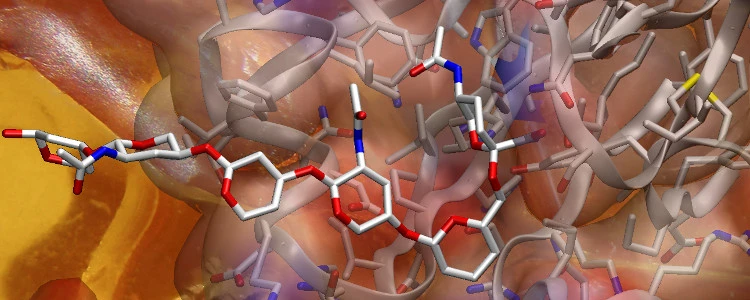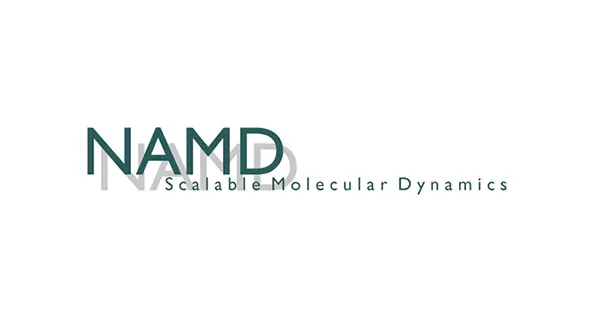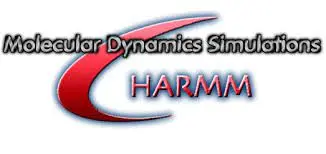Molecular Dynamics (MD)
Structural information is often not enough to predict the functions of complex molecular structures, such as proteins.
One of the current challenges in computational chemistry is therefore to describe the time evolution of molecular systems, trying to derive properties that would be otherwise impossible to obtain by simply considering their static three-dimensional structures.
To investigate the dynamical properties of a molecule we use a method named Molecular Dynamics (MD). Using this technique we can observe how a certain molecular system (e.g., protein) moves in time depending on its interatomic interactions.
This article aims to provide you with a general overview of the technique. Certain topics would require a more accurate description. For this reason, from time to time I will redirect you to other articles on this website where you can retrieve additional information on different aspects of Molecular Dynamics.
Advantages and disadvantages
MD is an extremely powerful tool for a variety of reasons.
First of all, it allows controlling the conditions of the experiment to an higher extent with respect to any existing experimental technique. We have complete control over all possible parameters and we can decide different ways to perturbate the system. Considering a protein, we can choose its initial conformation, and the ligands bound to it, we can perform mutations, change the protonation state, adjust the temperature, and so on.
Another leading advantage of MD is that we can assign a position to each atom at each time step resulting in a more detailed description of the progression of the system as it evolves from one configuration to another. In a sense, MD can be seen as a “computational microscope” allowing us to visualize molecular behaviour at an atomistic level.
For this reason, MD simulations are nowadays employed to gain insights into molecular systems at the atomistic level. Properties that are out of reach for standard laboratory experiments.
Despite all of the above, MD is far from being perfect and still shows some major drawbacks.
The first one is that MD is highly hampered by the computational resources at our disposal. This translates into the fact that MD is only able to deal with:
- Short processes taking place in the microsecond scale ().
- Small systems in the nanoscopic scale (). Meaning that we can model systems composed of thousands of molecules at most.
As a second point, it is important to note that such in silico observations are inherently model-driven. They are highly dependent on the quality of the available model for the system we want to simulate.
The results of a MD simulation are not always meaningful enough but must ultimately be verified by experiments. Ideally, simulations should be used in combination with experiments to provide the atomistic counterpart to the more macroscopic description that is obtained via experimental analysis.
- High control over the conditions of the experiment
- Visualization of molecular behaviour at the atomic level
- Only allows for analysis of small systems for small time scales
- Results depend on the quality of the available model
- Experimental confirmation is often required
Obtain the atomic motion via Molecular Dynamics
We mentioned that the main behind MD is to retrieve the motion of a given system. But how do we achieve this in practice?
The trajectory of a molecule is obtained by solving the classical equations of motions for a set of atoms.
The main idea is that, given the initial conditions of our system, using Newton’s second law () it becomes possible to obtain the force acting on each atom.
This information is then used to retrieve the position of each atom at the successive time step, therefore simulating the motion of the molecule. We can iterate this process for as long as we wish to simulate our system.
This comes with some problems.
First of all, solving equations of motion is not an easy task. As a matter of fact, it is not possible to find an analytical solution to the equations of motion for systems composed of thousands of atoms. We need to rely on numerical methods. Two of the most widely used are the Verlet algorithm, and the leap-frog algorithm.
If we don’t want to run into numerical problems we also need to make sure to select a time step that is small enough. Typically, a time step in the order of 1 or 2 fs (10s) is used. This means that each time we solve the equations we only proceed 1 fs further with our simulation.
To put this in perspective, a 1ns simulation will consist of 1 million steps.
On this website, you can find a more rigorous description of how to solve the equations of motion
Computing forces
We already specified that the movement of a molecule in MD is connected to the forces acting on each atom. These forces arise from interatomic interactions. Therefore, one fundamental aspect of a MD simulation is how we decide to compute them.
The interactions can be acquired at different levels of theory. The different options available are selected depending on the size of the system, and on the time scale of the process, we aim to study.
More rigorous descriptions (ab-initio methods) are based on Quantum Mechanics. Taking into account the quantum mechanical properties of atoms translates into higher accuracy, as well as prohibitively high computational cost in most cases.
One of the most common is the Molecular Mechanics or All-Atom level. This method ignores the quantum mechanical properties of molecules and simply approximates them as atoms held together by bonds (balls and springs). These classical mechanics representations allow considerable speed up in the calculations.
This is generally the right compromise between accuracy and computational cost. It allows us to treat reasonably large systems in the / scale which is typically enough to recover some useful information about our system.
In some cases, we may be interested in extremely large systems, or in processes occurring at higher time scales. In this case, we may decide to use a Coarse-Grained (CG) representation. In this method, we employ a simplified version of the molecule to compute the forces acting on atoms. By doing so we can speed up the calculations while still retaining reasonable accuracy.
Different steps required
Simulating the real behaviour of a molecule requires many different steps which are thoroughly discussed in other sections.
The main idea behind an MD simulation is not different from experimental analysis. First of all, we select an initial model and bring it to the desired conditions. Then, after the system is equilibrated, we proceed with the actual measurement.
MD works quite similarly. We solve the equations of motion until the system converges into a stable structure. At this stage, we can retrieve the pieces of information we desire.
The property of interest is an average over the measurements obtained in a given time frame. The higher the period of time over which we perform our average, the more accurate will be our evaluation of the property. Interesting quantities to compute are the thermodynamic ones, which can also be compared to the experimental obtained allowing us to assess the quality of our computer simulation.
In a conventional MD simulation, the total energy and the total momenta are conserved. Hence, we can assume that the measurements are carried out in a microcanonical ensemble (NVE), where the number of particles (N), the volume (V), and the total energy (E) are constant.
A microcanonical ensemble is not always the most appropriate to conduct an experiment. In a real lab, the vast majority of the reactions are carried out at constant pressure (P). For this reason, different techniques have been developed to carry out MD in different ensembles so that we can decide under which conditions we want to perform our simulation.
This is a pivotal topic in the field of MD. For this reason, I wrote two articles providing an accurate explanation of the algorithms needed to simulate a molecule at constant temperature, and constant pressure.
Different software to perform Molecular Dynamics simulations
Now that you have a basic understanding of MD you may ask yourself how to start with your own simulations.
Different software is nowadays available. Almost all of them require you to be familiar with a terminal and work with the command line.
Furthermore, in most cases, you will need to be comfortable with molecular visualization software to analyze the trajectories of the molecules. VMD is generally the way to go for trajectory analysis but you can also rely on PyMOL for structural visualization.
Here you can find a list of the most commonly used in the field, and a quick description of all of them. Each one of these programs has some unique capabilities but, in most cases, all of them should do fine.
I will leave you the link to the official website of each one of them so that you can get more details, and decide which is the one that best suits your interests.
GROMACS
“A free and open-source software suite for high-performance molecular dynamics and output analysis.”
GROMACS is a versatile, high-performance molecular dynamics simulation package that can be used to study the behavior of molecules and biomolecules in various environments. It is particularly well-suited for simulating biomolecular systems, such as proteins, nucleic acids, and lipids, and has been widely used in a variety of fields, including chemistry, biology, and materials science.
One of the key features of GROMACS is its ability to perform highly efficient simulations using advanced algorithms and techniques. These algorithms make it possible to simulate large systems with millions of atoms, and to do so with high precision and accuracy.
GROMACS is fast, well written, has a supportive community, and is able to fully exploits the resources of your computer. You can find a category of articles dedicated to GROMACS here.

Amber
“Amber is a suite of biomolecular simulation programs”
Don’t get confused. Amber is actually two things:
- A package of molecular simulation programs
- A set of force fields that are commonly used for the simulation of biomolecules
It is released in two parts: AmberTools, and Amber. The first one is free and available for everyone to download and use. On the contrary, you will need a license to use the second package.

NAMD
“NAMD is a parallel molecular dynamics code designed for high-performance simulation of large biomolecular systems.”
NAMD (Nano-scale Molecular Dynamics) is a molecular dynamics simulation software package developed by the Theoretical and Computational Biophysics Group at the University of Illinois. It can be used to study a wide range of problems in chemistry and biochemistry, including protein folding, enzyme function, and drug design. NAMD is available as a command-line program and can be used in conjunction with other software packages, such as VMD for visualization and analysis of simulation results.

LAMMPS
LAMMPS is a classical molecular dynamics (MD) code that models ensembles of particles in a liquid, solid, or gaseous state
LAMMPS (Large-scale Atomic/Molecular Massively Parallel Simulator) is a molecular dynamics simulation software package that is widely used for the simulation of materials and biomolecules. It is used to model a wide variety of systems including polymers, biomolecules, solid-state, and coarse-grained systems. Furthermore, it uses a collection of interatomic potentials (force fields) and boundary conditions.

CHARMM
A molecular simulation program with broad application to many-particle systems with a comprehensive set of energy functions, a variety of enhanced sampling methods, and support for multi-scale techniques including QM/MM, MM/CG, and a range of implicit solvent models.
CHARMM (Chemistry at HARvard Molecular Mechanics) is a molecular modeling and simulation software package developed at Harvard University. It is a widely-used program for simulating the behavior of biological molecules, such as proteins, nucleic acids, and lipids, as well as small organic molecules and polymers. CHARMM is a set of tools for model building and simulation analysis that is available as a command-line program and as a graphical user interface. It is compatible with several other software packages for molecular modeling and simulation.

Best resources to study Molecular Dynamics
If you are here that means you are probably new to the field of computational chemistry and looking to delve deeper into MD. In this section, I’ll provide you with a range of valuable sources that will enhance your understanding of MD.
To begin with, I highly recommend exploring the dedicated articles section on my website. As a seasoned practitioner, I’ve carefully curated a collection of insightful articles covering various aspects of MD. These articles serve as an excellent starting point to expand your knowledge and gain valuable insights.
If you prefer the classical way, you can go into books. They can be boring but provide some solid foundations. Here are a couple of recommendations that I’ve personally found beneficial but I am sure there are many others:
- Allen & Tildesley - Computer Simulation of Liquids.
- Frenkel & Smit - Understanding Molecular Simulation: From Algorithms to Application.
To further expand your understanding, I suggest exploring a couple of reviews. The first review provides a general overview of MD, offering insights into its principles and applications. The second review focuses specifically on the application of MD in the field of drug discovery, shedding light on its immense potential in this domain.
- Scott A Hollingsworth and Ron O Dror, Molecular simulation for all (2018)
- De Vivo et al., Role of Molecular Dynamics and Related Methods in Drug Discovery (2016)
If you have any further questions or need more recommendations, feel free to reach out!